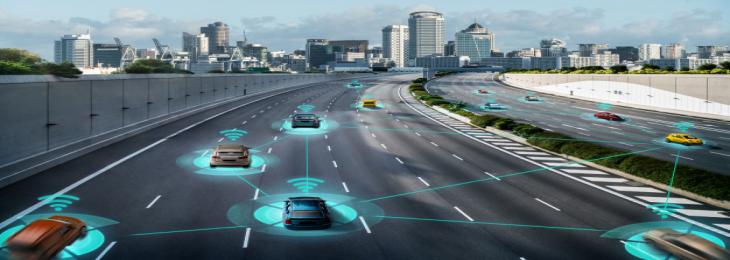
An intelligent transportation system (ITS) is a newfangled technology that focuses to provide innovative services related to different traffic management systems and transport systems. Moreover, it enables users to be better informed and make coordinated, smarter, and safer use of transport networks. ITS aims at achieving traffic efficiency by reducing traffic problems. This technology provides prior information about seat availability, real-time running information, traffic, etc. to the user, which reduces travel time and enhances the user’s safety and comfort.
Working in the Intelligent Transportation System
The traffic management center (TMC) is a vital unit of ITS. This technical system is administered by the transportation authority. In this system, all the data are gathered, processed, and analyzed for further operation and control management of traffic, to provide real-time data and details about local transportation vehicles. Proficient operations and well-organization of traffic management center depends on automatized data collection with precise location information, analyzing data to generate precise traffic information, and then reverting this accurately analyzed data back to travelers. Data collection, data transmission, data analysis, and travel information are the four stages of ITS. The detailed information to understand the entire process is given below:
- Data acquisition: Rapid, complete, and accurate data collection and communication is critical for real-time monitoring and strategic planning in the traffic management system. A good data acquisition management communication system combines tested hardware and efficient software that can collect reliable data for further ITS activities. The different ITS hardware equipment used include sensors, cameras, automatic vehicle identifiers (AVI), and servers that can store a huge amount of data for meaningful interpretation.
- Data Analysis: Data analysis includes data cleaning, fusion, and analysis. The data from the sensors and other collection devices that are transmitted to the TMC must be checked. Inconsistent data must be weeded out and clean data has to be retained. Further, the data from different devices may need to be combined or fused for further analysis. The cleaned and fused traffic data will be analyzed to estimate and forecast traffic situations. These traffic situation estimation methods will be used to provide suitable information to users.
- Traveler Information: Travel advisory system facilities are used for relaying transportation-related information to the monitoring public. These include variable message signs, internet, highway advisory radio, short messaging services, automated cellphone messaging, public radio announcements, television broadcast, and other modern media tools. Such systems can provide real-time information on travel times, travel speeds, accidents, delays, route closures, and detours, and work zone conditions, among others.
Issues such as increasing accidental cases, inadequate road development, and infeasible demands to extend new roads can be solved using intelligent transport system where transportation system is safer, efficient, secure, and faster through the use of control technologies. Moreover, this can tackle the rising congestion that increases travel time and industry costs and can help in reducing environmental impacts caused by transport.
An intelligent transport system, communication systems, automated traffic prioritization signals, information processors, GPS updates, sensors, and roadside messages play an imperative role in the application of advanced commercial vehicle operations system, advanced public transportation system, advanced traveler information system, advanced rural transportation systems, advanced vehicle control system, and advanced traffic management system. The intelligent transport system has been divided into four main sets based on their implementation in different aspects of transportation management i.e. ATMS (Advanced Traffic Management System), EMC (Emergency Management System), ATIS (Advanced Traveler Information System), and APTMS (Advanced Public Transportation Management System).
Advanced traveler information system (ATIS) includes internet, radio, television, telephones, phones, etc. to assist drivers and travelers in making informed decisions regarding optimum routes, available modes of travel, and trip departures. This system provides pre-trip information and en-route information to the driver, which is helpful in many ways. En-route data helps a traveler avoid congestion, saves travel time, and improves traffic network performance. Pre-trip data helps travelers to use freeways and allows commuters to make better-informed transit choices.
Advanced traffic management system (ATMs) collaborates several systems such as message system, vehicle detection, CCTV, communication, etc. within a coherent single interface that predicts traffic conditions for more efficient planning and operation and provides real-time data. Freeway operations management systems, dynamic traffic control systems, and incident response systems, etc. respond in real-time to changing conditions.
Advanced public transportation system (APTS) applies state-of-the-art transportation management and information technologies to public transit systems to enhance the efficiency of operation and improve safety.
It includes an automatic vehicle location system, a real-time passenger information system, systems providing priority of passage to buses at signalized intersections, and a bus arrival notification system. Bus Rapid Transport (BRT) systems are viable alternatives to traditional light rail public transport. Instead of train or metro, the BRT system uses buses to ply a dedicated lane that runs lengthwise along the center of the road. The city of Pune was the first to experiment with a BRT system.
Emergency management system (EMS) is the latest research field in the intelligent transport system. This transport system mainly focuses on providing help in emergency situations.
Advanced traveler information system (ATIS) provides users travel-related information, to assist decision-making on estimate route choices, travel times, and avoid congestion. This can be achieved by providing different information using various technologies such as, dynamic road message signs for real-time communication of information on bottlenecks, traffic congestions, accidents, and separate route information during road closures and maintenance, GPS enabled in-vehicle navigation system and website that provides a colored network map in red, green and yellow color showing congestion levels on highways. The basic objective of ATIS is to inform road users of the latest traffic updates and better management of traffic. Internet, SMS, and radio have been employed for updates. Few Indian cities have implemented these protocols. Bangalore and Hyderabad, Chennai, and Delhi have installed the ATIS system.
Advanced traffic management system (ATMS) is one of the most prominent and used branches of ITS, which helps in managing congested traffic situations. Two algorithms were used in discovering this system, data fusion for analysis of congestion, and selection of control plan. GPS plays a vital role in collecting traffic data such as travel delay, time, and speed.
Numerous ITS applications have been developed by various organizations across the globe and tailored to offer transportation solutions to meet specific needs. In developed countries, road operators have become dependent on ITS for not only congestion and demand management but also for road safety and improved infrastructure.
Intelligent Transport System Across the World
The U.S. Department of Transportation coordinates with the ITS research activities in the country through its Research and Innovative Technology Administration (RITA). This wing combines cutting edge research with technology transfer and aims to improve the country’s transportation system. The main aim of RITA includes coordinating, facilitating, and reviewing research and development programs & activities of the in-house team as well as academic and industrial partnership, developing innovative concepts for traffic management through small business innovative research (SBIR) programs, educating the general public in transportation-related fields.
The ITS efforts in Japan collates improvements in the fields such as advances in the navigation systems, electronic toll collection, assistance for safe driving, optimizing traffic management, increasing efficiency in road management, support for public transport, support for pedestrians, and support for emergency operations.
Mainland Europe’s ITS falls under the umbrella of Road Transport Information (RTI) that focuses on two interacting programs: Dedicated Road Infrastructures for Vehicle safety in Europe (DRIVE) and PROgram for European Traffic with Highest Efficiency and Unprecedented Safety (PROMETHEUS). System development is the primary goal of PROMETHEUS project, while DRIVE focuses on human behavior issues and implementation of systems in the European community.
Inspired by the traffic efficiency and safety in European roads due to the introduction of ITS, the Middle East, whose transportation sector is expanding, implemented the ITS system. Dubai municipality stated the implementation of project ITS Dubai, which is considered to be the first comprehensive ITS project in the Middle East and one of the most sophisticated ITS projects currently being implemented.
The ITS program in India is aimed at ensuring safe, affordable, quick, comfortable, reliable, and sustainable access for the growing urban and rural population. ITS has been implemented in few cities in India such as Chennai, New Delhi, Pune, Bangalore, etc. focusing on stand-alone deployments of area-wide signals control, parking, information, advanced public transportation, toll collection, etc.
Moreover, some successful implementations of ITS-UK include internet-based maps aimed at freight transport. In London, ‘Transport for London’ (TfL) have produced a digital map of London roadways speed limit, which is available free of charge for personal as well as commercial use. Cameras have been installed on major routes across the country to monitor journey times and traffic flow.
Conclusion
Increasing urbanization and the number of vehicles on road will result in rising demand for maintaining a traffic management system. With due concern, it puts enormous pressure on cities to maintain and regulate the traffic system so that the city keeps moving hassle-free. To meet this purpose, an intelligent transport system is an absolute solution. The intelligent transport system is a win-win situation for both citizens and city administrators, where it provides safety and comfort to citizens and easy maintenance and surveillance to city administrators.






